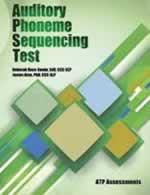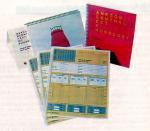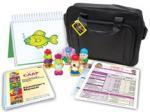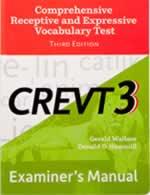TEXL: Test of Expressive Language
Interest Level:
Additional Components:
Test, Manual, Picture Book and Record Booklets
This product requires a check of customer qualifications.
CLICK HERE to download qualifications form.
Testing Time: 20 to 30 minutes Administration: Individual The new Test of Expressive Language (TEXL) is a highly reliable and valid measure of a child’s expressive spoken language ability. The test measures a child’s ability to produce the following categories of English language forms: Vocabulary: Word classes such as nouns, verbs, adjectives, and adverbs, and of words that represent basic percepts and concepts. Grammatical Morphemes: Function words (e.g., prepositions,...
Testing Time: 20 to 30 minutes
Administration: Individual
Administration: Individual
The new Test of Expressive Language (TEXL) is a highly reliable and valid measure of a child’s expressive spoken language ability. The test measures a child’s ability to produce the following categories of English language forms:
- Vocabulary: Word classes such as nouns, verbs, adjectives, and adverbs, and of words that represent basic percepts and concepts.
- Grammatical Morphemes: Function words (e.g., prepositions, pronouns, determiners) and inflections (e.g., bound morphemes such as noun number and case, verb number and tense, noun verb agreement, and derivational suffixes).
- Elaborated Phrases and Sentences: Syntactically based word relations and elaborated phrase and sentence constructions, including the modalities of single and combined constructions (interrogative sentences, negative sentences, active and passive voice, direct and indirect object), embedded sentences, and partially and completely conjoined sentences.
The TEXL was co-normed with and is a companion to the Test for Auditory Comprehension of Language Fourth Edition (TACL-4). Clinicians who have given both TACL-4 and TEXL to the same child can combine these scores to obtain a comprehensive measure of language ability across linguistic features (semantics, morphology, and syntax) as well as overall oral language ability using the reproducible TACL-4/TEXL Summary Form.
The TACL-4/TEXL Summary Form provides space to record TACL-4 and TEXL scores, calculate additional composite scores, conduct receptive-expressive discrepancy analyses, and profile these scores. These scores provide comprehensive information on oral language skills comparable to scores derived from the Test of Language Development- Primary, Fourth Edition (TOLD-P:4; Newcomer & Hammill, 2008), Test of Language Development- Intermediate, Fourth Edition (TOLD-I:4; Hammill & Newcomer, 2008), Oral and Written Language Scales, Second Edition (OWLS-II; Elizabeth Carrow-Woolfolk, 2011), Clinical Evaluation of Language Fundamentals, Fifth Edition (CELF-5; Semel, Wiig, & Secord, 2013), and the Comprehensive Assessment of Spoken Language (Carrow-Woolfolk, 2008).
Features
- Enhanced assessment of oral language skills when used in combination with the TEXL and the free reproducible TACL-4/TEXL Summary Form.
- All-new nationally representative normative sample of 1,205 children in the U.S.
- Characteristics of the normative sample were stratified by age relative to region, gender, ethnicity, socioeconomic factors, and other critical variables and are the same as those reported for the preschool and school-age population reported in the Statistical Abstract of the United States 2013 (ProQuest, LLC, 2012).
- Age-related entry points, basals, and ceilings ensure that testing time is kept to a minimum and children are only tested on the items that are optimal for their ability level.
- Each item on the test was evaluated using both conventional item analyses to choose "good" items, and the new differential analyses to find and eliminate potentially biased items.
- Reliability coefficients were computed for subgroups of the normative sample as well as for the entire normative group.
- A major effort has been made to demonstrate conclusively that the test is both reliable and valid, including diagnostic accuracy analyses, particularly rigorous techniques involving the computation of the sensitivity index, specificity index, the receiver operating characteristic/area under curve (ROC/AUC).
- The TEXL was co-normed with the Test for Auditory Comprehension of Language Fourth Edition (TACL-4; Carrow-Woolfolk, 2014).
Description of TEXL
Each item is composed of a word or sentence and a corresponding picture plate. The examiner reads the stimulus aloud and the subject is asked to answer a question, finish a sentence, or combine sentences based on the stimulus provided. The TEXL test items are ordered according to difficulty within each of the three subtests. Entry points, basal and ceiling rules for scoring are provided for each subtest.
The Examiner’s Manual includes a comprehensive discussion of the test's theoretical and research-based foundation, item development, standardization, administration and scoring procedures, norms tables, and guidelines for using and interpreting the test’s results. Reliability and validity studies were conducted out with individuals with normal language abilities and individuals who had previously been diagnosed with learning disabilities, ADHD, deaf or hard of hearing, articulation disorder, language impairment, Autism spectrum disorder, intellectual disorder as well as those who have been identified as gifted and talented.
TEXL coefficients alpha range between .93 and .95 for the subtests and is .97 for the Expressive Language Index. Average correlations with popular criterion measures of expressive language ability range from .72 to .86. Studies of diagnostic accuracy as it relates to sensitivity (median = .79), specificity (median =.91), classification accuracy (median = .86), and receiver operating characteristic/area under the curve (median = .95) are reported.
Complete TEXL Kit includes: Examiner’s Manual, Picture Book, 25 Examiner Record Booklets, and TACL-4/TEXL Comprehensive Scoring Supplement, all in a sturdy storage box. (©2014)
User Qualifications:
To administer this test at least a master’s degree is required, with state licensure OR certification from a professional organization (ASHA, AOTA, APA, AERA, ACA, AMA, NASP, NAN, INS) that requires formal training and experience in ethics, psychometrics, statistics, and scoring and interpretation. Tests of perceptual, academic, and functional processes used in schools, clinics and rehabilitation settings are of this level. “All test users, regardless of level and profession, are expected to abide by the standards set forth by the APA, AERA and NCME regarding the ethical use, protection and dissemination of all test materials. All orders for the products listed below, must be placed on official institutional purchase order forms or professional letterhead.
The purchase of this product requires a check of customer qualifications.
CLICK HERE to download qualifications form.
Orders for items on this page cannot be completed online. Please attach completed qualifications form to your institutional purchase order or professional letterhead when ordering this product. For questions or help placing your order for these items call (800) 880-4433.
To create a requisition form:
- Enter a Quantity for the item(s) desired
- Click Add to Cart
- Click Print a requisition list
Item #
Products
Price
Wishlist
Qty
Requested quantity is not available at this time
YP1671YY
TEXL: Complete Kit
$460.00
Requested quantity is not available at this time
YP1672YY
TEXL: Examiner Record Booklets (25)
$95.00
Requested quantity is not available at this time
YP1673YY
TEXL: Examiner's Manual
$140.00
Requested quantity is not available at this time
YP1674YY
TEXL: Picture Book
$245.00




